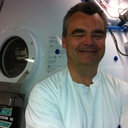Acta Ophthalmologica 2019-Jul
Periocular necrotizing soft tissue infection in Greater Copenhagen.
只有注册用户可以翻译文章
登陆注册
链接已保存到剪贴板
关键词
抽象
METHODS
All patients diagnosed with PNF at Copenhagen University Hospital from 2008 to 2018 were included. Their electronic medical records and pathology reports were assessed, and available tissue specimens were reviewed and stained with monoclonal antibodies for CD1a+ Langerhans' cells, CD3+ T lymphocytes, CD15+ granulocytes, CD44+ lymphohematopoietic cells, CD68+ histiocytes, CD79α+ B lymphocytes, and FXIIIa+ dendritic macrophages and Langerhans' cells. The number of positive cells was counted, and an average score was calculated. The location of immune cells and bacteria was assessed.RESULTS
The specimens were characterized by acute inflammation and necrosis of the fascia, while striated muscle involvement was less frequent. Haemolytic group A streptococci and Staphylococcus aureus were identified and mainly located in the deep dermis and subcutis in close relation to the fascia. Only few areas harboured both bacteria and inflammatory cells. Granulocytes, histiocytes and CD44+ lymphohematopoietic cells were demonstrated to be abundant in all patients, while B and T lymphocytes, dendritic macrophages and Langerhans' cells were less frequent.

